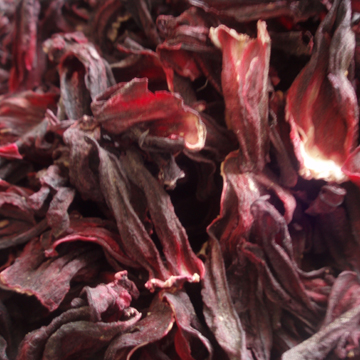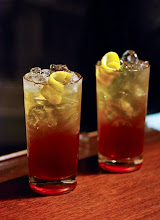Flowers. To be sure, not an ingredient that many folks think of when the subject of cookery or cocktails comes up, other than as a particularly fancy garnish item perhaps. But the often-refreshing complexities that so many varieties of edible flora can offer when paired with food or spirits can be nearly limitless in their possibilities:
If you fancy tea at all, you've doubtlessly enjoyed a cup of Chamomile now & again. And what would our much-beloved Gin be without its wide array of botanicals - many of which are floral in nature? Or, to a further degree, what of the wonderfully-delicate flavors of Rosewater, Parfait Amour, Creme de Violette, or Elderflower Liqueur? Yet, as the links above should indicate, a great many quality mixologists here on the Interweb have covered these topics quite thoroughly in their past writings, with one peculiar exception: Hibiscus.
 This beautiful flower, also known as rosemallow or roselle, is a fairly common addition to many herbal teas and is quite often compounded into a tisane all by itself. It posesses a dry, discernably floral aroma & a bright, clean flavor not entirely dissimilar to an unsweetened Cranberry juice. I was first introduced to a cold Hibiscus tisane, known as Jamaica (sometimes Yamaica) by former co-workers of mine from Oaxaca, where the tart drink - sans alcohol - is quite popular.
This beautiful flower, also known as rosemallow or roselle, is a fairly common addition to many herbal teas and is quite often compounded into a tisane all by itself. It posesses a dry, discernably floral aroma & a bright, clean flavor not entirely dissimilar to an unsweetened Cranberry juice. I was first introduced to a cold Hibiscus tisane, known as Jamaica (sometimes Yamaica) by former co-workers of mine from Oaxaca, where the tart drink - sans alcohol - is quite popular. Now, Jamaica (pronounced Ya-mai-ca, by the way) is incredibly cheap & simple to prepare (look for it in Hispanic or Caribbean groceries), and makes an excellent mixer, as a certain Flighty mixologist will attest (OK, so I lied, one other person has discussed this stuff). But, this is certainly not the only use Hibiscus, and the floral qualities it imparts, can have in mixology. Enter another topic near & dear to my heart: syrups, in this case the oh-so-rarified Pomegranate Grenadine.
A quintessential mixer in a wide variety of drinks, real Grenadine is an invaluable ingredient for adding a touch of sweetness, color and its own touch of refreshing favor on which other elements of a cocktail may be highlighted. Some great recipes for making it at home abound, but I wondered how I might add something new to this already well-covered matter. Simple - incorporate a touch of Hibiscus to one's Grenadine, like so (©):
2 Cups: white Sugar
1 Cup: Water
¼ Cup: dried Hibiscus flowers
1 whole Pomegranate, seeded
In a saucepan, bring the sugar & water to a simmer, stirring to dissolve the sugar. Add the Pomegranate seeds & Hibiscus flowers and simmer on medium heat for about twenty minutes, stirring occasionally. Allow to cool then strain by preferred method (cheesecloth, strainer, &c.), add an (optional) ounce of vodka as a preservative & bottle.
Enjoy it almost anywhere you would normal Grenadine, or in a (©):
1½ oz. Laird's 100º Bonded Apple Brandy
¾ oz. fresh Lemon juice
¼ oz. fresh Lime juice
1½ Teaspoons: Hibiscus Grenadine
Shake well with cracked ice & strain into a cocktail glass.
As many astute readers will doubtlessly notice, this cocktail is merely a riff on the classic Jack Rose, but between the choice in spirit (a mild Calvados works passably also), the use of both Lemon & Lime (which really smooths out the wrinkles often present in the JR) and the floral notes of the Hibiscus, it becomes a whole different bit of fauna...
Cheers & Enjoy!
.jpg)
.jpg)


.jpg)

.jpg)






